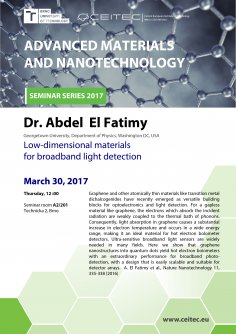Graphene and other atomically thin materials like transition metal dichalcogenides have recently emerged as versatile building blocks for optoelectronics and light detection. For a gapless material like graphene, the electrons which absorb the incident radiation are weakly coupled to the thermal bath of phonons. Consequently, light absorption in graphene causes a substantial increase in electron temperature and occurs in a wide energy range, making it an ideal material for hot electron bolometer detectors. Ultra-sensitive broadband light sensors are widely needed in many fields. Here we show that graphene nanostructures into quantum dots yield hot electron bolometers with an extraordinary performance for broadband photodetection, with a design that is easily scalable and suitable for detector arrays. A. El Fatimy et al., Nature Nanotechnology 11, 335-338 (2016)
Change institution
- About Institution
- Research
-
Core Facilities
- CEITEC Nano Research Infrastructure
- Biomolecular Interactions and Crystallization
- X-ray Diffraction and Bio-SAXS Core Facility
- Nanobiotechnology Core Facility
- Josef Dadok National NMR Centre
- Cryo-electron Microscopy and Tomography
- Proteomics Core Facility
- Plant Sciences Core Facility
- Cellular Imaging Core Facility
- Genomics Core Facility
- Multimodal and Functional Imaging Laboratory
- PhD School
- News/Events
- Contacts








